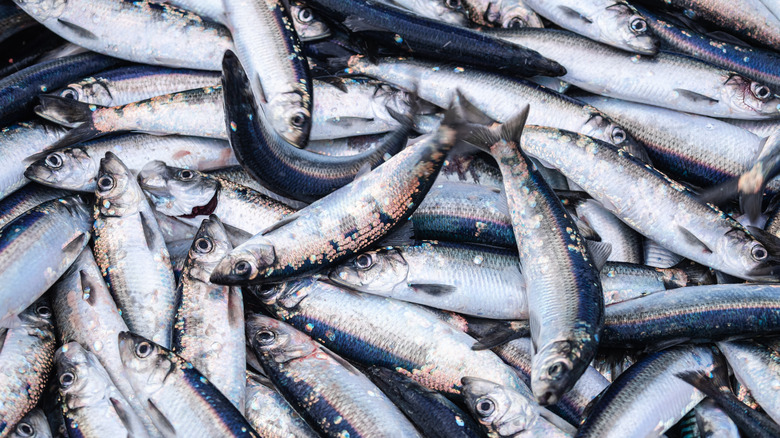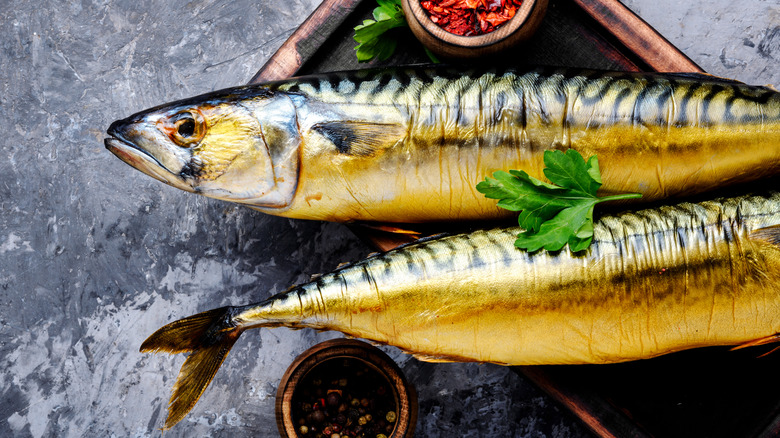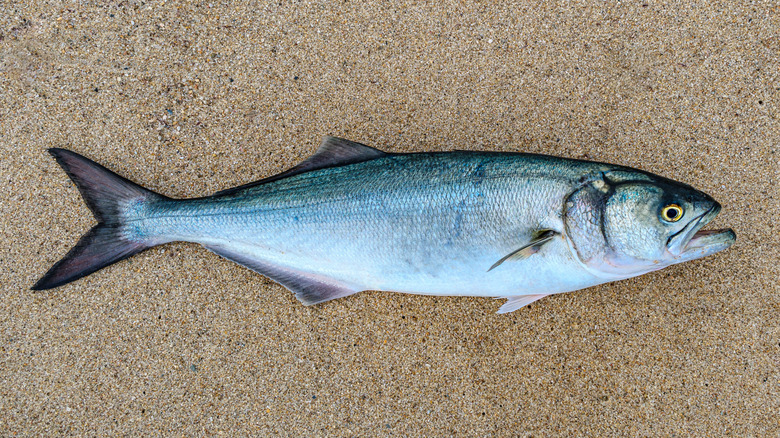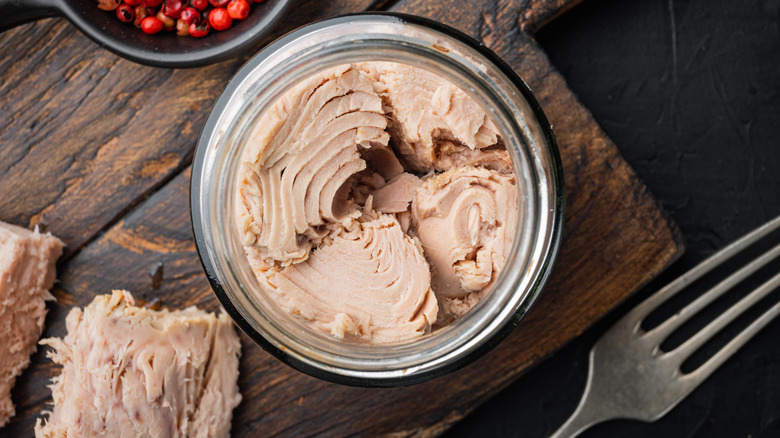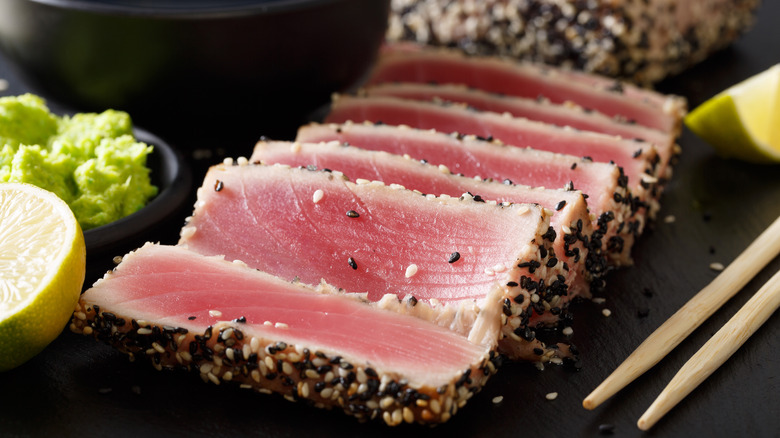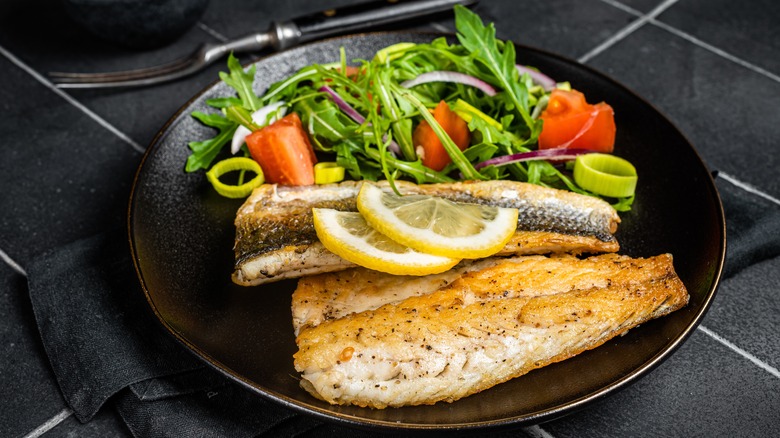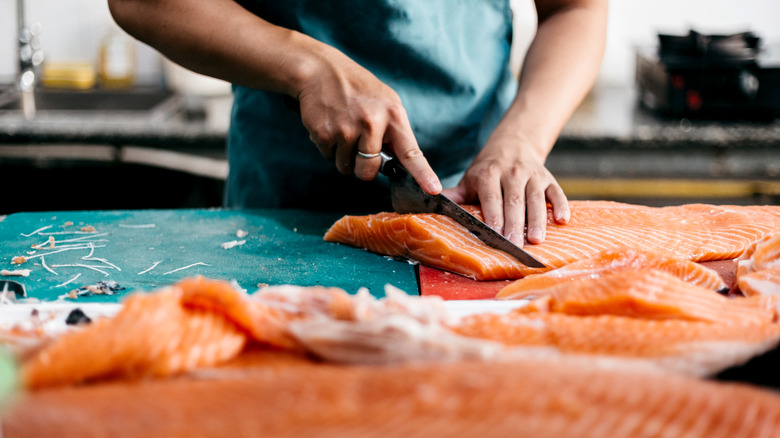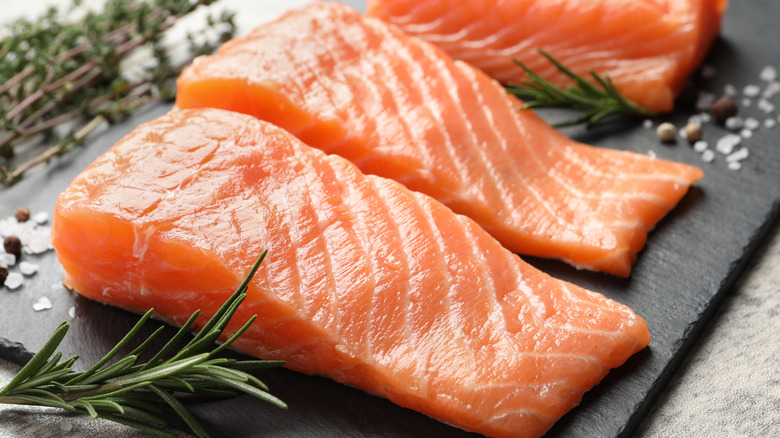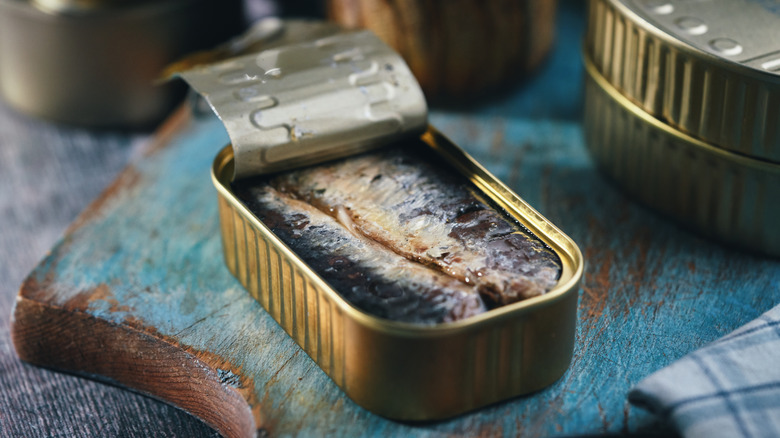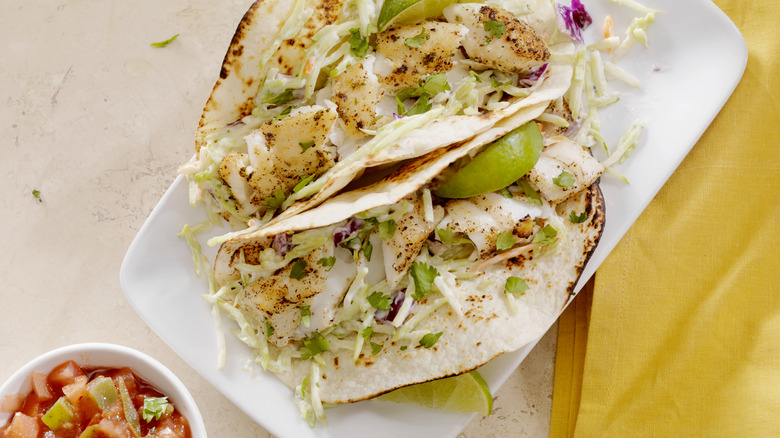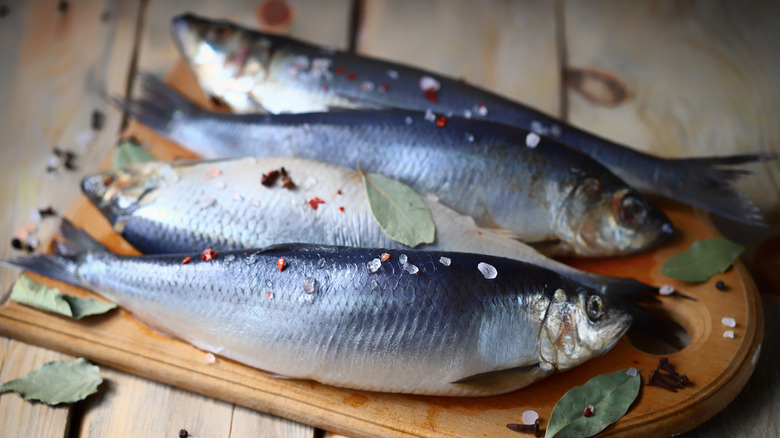8 Fish You Can Eat Regularly And 8 You Should Avoid
Whether you're craving a spicy tuna roll or a nice piece of grilled salmon, there are hundreds of fish recipes that can serve as a lean and protein-rich dinnertime favorite. But what kinds of fish can safely be eaten often, and what kinds of fish are best to steer clear of?
Two of the biggest concerns when considering which fish can be safely consumed throughout the week are dietary health and cost. Mercury is a common concern for fish eaters, as most seafood contains mercury, and consuming high levels can lead to health issues. Seafood can also put a strain on your day-to-day food budget as fish is often more expensive than other kinds of meat.
Sustainability is also a major factor when considering which fish are safe to eat on a regular basis and which are not. Some types of fish multiply fairly easily and can be farmed or caught without causing harm to the species or environment, making them a worthwhile catch for seafood lovers. Other fish, however, live in more delicate conditions which can be upset easily due to overfishing.
Buy: Atlantic Mackerel
A very common commercial species of fish, the Atlantic mackerel also sometimes goes by Boston mackerel, Scottish mackerel, or Norwegian mackerel– but it's important to remember that there are many different types of mackerel out there. While market prices can vary from season to season, Atlantic mackerel typically sells for anywhere from $5 per pound frozen to $25 per pound fresh. They are harvested in the wild and are extremely common in the northern parts of the Atlantic Ocean.
With a slightly milder flavor than tuna, Atlantic mackerel is an easy and accessible fish that can be added to sandwiches, pasta dishes, or cold salads without imparting any overpowering briny flavors. Safe to eat twice to three times per week, this fish is far lower in mercury than more predatory fish (such as swordfish) while it remains high in omega-3 fatty acids and other powerful nutrients like calcium, magnesium, and potassium.
Avoid: Bluefish
Also known as snapper, bluefish has a particularly fishy taste and a delicate meat structure. It's best grilled, baked, or pan-fried, but bluefish can also be poached or smoked. Depending on the season and region, in addition to the quality of the fillet, fresh bluefish tends to cost roughly $12 to $30 per pound.
There are a handful of reasons that bluefish should not be eaten regularly, starting with the fact that it does not keep well. It is recommended that bluefish is prepared as quickly as possible after catching it as it goes bad quickly and doesn't take well to freezing. Not only does it contain a high amount of mercury, but it's also a predator and is currently under threat of being overfished, though conservation efforts to rebuild the bluefish population are ongoing. All of this makes the bluefish an unsustainable choice as well as a potentially hazardous one. PCBs (polychlorinated biphenyls), which are highly carcinogenic, are also commonly found in bluefish, so this is one best avoided or saved for rare occasions.
Buy: Canned Light Tuna
Shelf-stable light tuna that can be bought in cans and pouches is not usually made up of one kind of tuna, but rather is an assortment of smaller varieties of tuna, like skipjack. Low in fat while rich in protein, omega-3 fatty acids, and a variety of other vitamins and minerals, light tuna is still a very healthy fish option. It's also particularly accessible as cans of light tuna can go for as little as $1 or less.
Canned light tuna should be distinguished from canned white tuna (also known as albacore tuna), however, as the latter contains nearly three times as much mercury as the former. Regarding canned light tuna, the Environmental Defense Fund notes: "Children under six can eat up to three 3-ounce portions per month. Older children and adults can safely eat it once a week." Canned white tuna is a different story: "Children under six can eat up to one 3-ounce portion a month; children from 6 to 12, two 4.5-ounce portions a month. Adults, including pregnant women, can safely eat this kind of tuna up to three times a month." Note that there are over a dozen varieties of tuna, each with their own health concerns fish eaters ought to be wary of.
Avoid: Bigeye Tuna
A different type of tuna that is best eaten in small doses, if at all, is bigeye. Bigeye tuna, along with yellowfin tuna, is a type of ahi and is most typically fished in warm or temperate climates. Bigeye's meaty flavor, rich fat content, and bright red color when raw make it a popular type of tuna used in Japanese cuisine, namely for sushi and sashimi. It can also be cooked as a steak. Based on the quality of the fillet as well as seasonal availability, the price point on bigeye can vary greatly. At a range of $40 to $200 per pound, it comes in second to bluefin as the most expensive type of tuna on the market.
In addition to the health concerns around bigeye tuna's high mercury content, their decrease in population over the last few decades has led the species to earn a vulnerable status with the International Union for Conservation of Nature. While bigeye are sustainably fished in the Pacific Ocean, they are being overfished in the Atlantic and Indian Oceans.
Buy: Freshwater Bass
There are many types of freshwater bass, including largemouth bass, striped bass, yellow bass, and others. These are common in recreational fishing and can be found throughout North America. While flavor profiles can vary widely between each kind, bass is typically mild with a somewhat watery taste. Many bass species can be caught for free with the correct fishing permit based on the area. Mostly available as a game fish, it's difficult to find freshwater bass fillets sold in stores.
Some types of bass, like black bass, were once zealously overfished as they are a popular sport fish, commonly sought after in prize fishing and competitions. Ongoing conservation efforts and many catch-and-release campaigns revived their numbers, though, so now freshwater bass are abundant. Freshwater bass is high in omega-3 fatty acids, an excellent source of protein, and contains a high amount of vitamin B12. To note, freshwater bass can be higher in mercury levels than other types of freshwater fish, so limit consumption to six or fewer servings per month.
Avoid: Saltwater Bass
Saltwater bass, or sea bass, is an incredibly popular catch for hobby fishers worldwide. Typically found throughout the Atlantic and Pacific Oceans (depending on the type), they offer lean and tender meat that flakes easily when cooked — along with a distinct, briny flavor that is standard among saltwater fish. Pricing varies widely, but typically a catch of Chilean sea bass can cost upwards of $30 per pound.
While saltwater bass tends to fall into the mid-range of mercury levels in fish, the main reason not to overindulge is conservation. Chilean sea bass, also known as the Patagonian toothfish, is a particularly slow-growing fish, so populations are difficult to replace – especially with the popularity of prize fishing. This species also has one of the highest mercury loads of saltwater bass species. Other types of sea bass, like calico bass or sand bass, do not grow as large and are harder to fish for at scale.
Buy: Catfish
Catfish might not always be the most attractive or lucrative catch of the day, but they are chock full of health benefits. Catfish is rich in nutrients like vitamin B12, which is beneficial for the brain and heart. It also contains a high level of omega-3 fatty acids, which can help with skeletal muscle strength and enrich gut bacteria. High in protein and low in fat, catfish have evolved from their humble origins as a swamp fish to a veritable superfood. Catfish are also fairly inexpensive, going for between $1 to $2 per pound on market average. With a firm but flaky texture and a mildly sweet flavor, catfish can be cooked in dozens of ways, such as fried with a side of tartar sauce.
Listed by the Food and Drug Administration as well as the Environmental Protection Agency as a fish that contains notably lower mercury levels, this is another choice that is safe to eat more regularly.
Avoid: Monkfish
Monkfish, a type of anglerfish, are a tricky species of fish for a handful of reasons. With a sweet flavor that some eaters compare to lobster meat, monkfish is another highly versatile choice as it can be cooked using a wide variety of methods, such as pan-frying, grilling, or baking. Monkfish fillets, depending on their quality, can go from as low as $7 per pound up to $20 per pound either fresh or frozen, and two of the most common varieties, the white monkfish and black-bellied monkfish, are sought after for their hearty, chewy texture.
Because monkfish can sometimes live 10 years or even longer, this one is better to avoid eating as mercury levels in a fish's system increase the longer the fish lives. They are not under any advisories for conservation as general numbers for the population size of monkfish are unknown, but there are catch limits in place to ensure overall sustainability.
Buy: Wild-Caught Salmon
Wild-caught salmon tends to be somewhat pricier than farmed salmon because demand can often exceed the supply, but it can still be somewhat affordable. Alaskan sockeye salmon typically goes for between $13 and $30 per pound while more choice cuts can go up to $100. With firm flesh and a high fat content, salmon is a great option for grilling, making fish steaks, or accompanying a starch (like this recipe for coconut rice with salmon and cilantro). It has a slightly oily texture that takes well to being smoked, which is why salmon is dried more commonly than other fish.
The benefit of wild-caught salmon is that it usually contains a lower level of carcinogens, and Pacific salmon in particular tends to be lower in dioxins, an environmental pollutant that can cause developmental damage as well as issues with the immune system and hormonal imbalances. So the next time you dish up a salmon fillet, double-check that it was fished in the wild first.
Avoid: Farmed Salmon
While very similar to its counterpart wild-caught salmon, farmed salmon can often be bought at a lower price as it is more frequently available. At around $6 to $7 per pound, it's a very budget-friendly fish, and frozen fillets can be found at most grocery stores across the United States.
There are, however, several reasons why farmed salmon is worth avoiding in favor of wild-caught. Salmon, whether farmed or caught, is generally lower in mercury, PCBs, and other contaminants than many other types of fish, though some research suggests that these levels are higher in farmed salmon. Farmed salmon is also slightly higher in fat and lower in protein than wild-caught salmon, and it contains lower percentages of B vitamins and other nutrients — so if you're in search of a salmon option that retains a higher level of health benefits, wild-caught is preferable. It's also worth noting that the net pens used in salmon farming are vulnerable to pollution and sea lice, and there are concerns over escaping fish disrupting the native environment where they are being farmed.
Buy: Sardines
According to registered dietitian Julia Zumpano, who spoke with the Cleveland Clinic, "You can't go wrong with sardines. They're a wonderful source of omega-3 fatty acids, they're caught in the wild, and they're cheap." A tin of sardines can be purchased for a dollar or less at many supermarkets, and even premium sardines can suit a budget-conscious shopping list. With a milder, softer flavor than anchovies, sardines are another canned fish favorite, often packed in olive oil for a snack that's easily eaten right out of the tin or dressed on top of a salad or cracker.
Notable facts about sardines include that, whether fresh or canned, they are loaded with vitamins D and B12 in addition to calcium, protein, iron, zinc, and more. Even lower in mercury than tuna and with a small environmental impact due to its enormous population, this is both a safe and sustainable fish to try as well as a healthy alternative to meat.
Avoid: Orange Roughy
Sometimes known as red roughy, slimehead, or deep sea perch, orange roughy has a delicate flavor that is slightly sweet with a moist, flaky texture. When available, frozen bags of orange roughy fillets can sometimes be found for as little as $10 per 12-ounce bag, but premium cuts of fresh orange roughy can sell for hundreds of dollars. That said, it is a very rare fish as restrictions have been put in place by various agencies to prevent overfishing.
Orange roughy are dangerous for two major reasons. Firstly, they have incredibly long lifespans, sometimes living more than 100 years. This means that their opportunity to absorb toxins and retain mercury is far higher than younger fish. Secondly, because orange roughy reproduce slowly, their populations are particularly susceptible to overfishing. Because of this, conservation efforts recommend not eating them at all so that the species may have ample opportunity to repopulate.
Buy: Rainbow Trout
With a delicate flavor that some eaters describe as a little nutty, rainbow trout is often compared to salmon as they share a similarly flaky texture — and are part of the same family. It can easily be grilled, baked, or pan-fried (like in this bacon-wrapped rainbow trout recipe), and it can be paired with both sweeter and saltier ingredients to create a well-rounded meal. Farmed rainbow trout is usually cheaper than fresh-caught and can range anywhere from $2 to $8 per pound depending on the quality and the season. While it's a trickier fish to find in recreational fishing, it can be caught throughout North America, particularly in southern Canada, the Great Lakes region, and in southern states like Georgia.
Both farmed and fresh rainbow trout contain several health benefits, including a high protein content, vitamins D and B12, and heart-healthy omega-3 fatty acids. They are listed by the Food and Drug Administration as having a low mercury count compared to other fish, and because they reproduce fairly quickly, there is no worry regarding the rainbow trout's sustainability.
Avoid: Imported Longline Mahi Mahi
Mahi mahi, sometimes known as dolphin fish, has firm meat and a mild taste, comparable to the flavor and texture of swordfish. Averaging around $15 to $40 per pound, it is easily grilled or barbecued as a steak fillet or incorporated into handheld dishes such as mahi mahi tacos for a tasty alternative to meat. It's also safe to eat raw and is sometimes used in sushi and sashimi recipes.
While not all types of mahi mahi need to be avoided as most kinds only contain a moderate amount of mercury, imported longline mahi mahi is a particularly unsustainable and ecologically damaging choice. Bycatch, which is what happens when fishing equipment accidentally ensnares additional sea life like turtles and dolphins, is a major concern for longline caught mahi mahi from Guatemala, Costa Rica, Panama, Peru, Ecuador, Indonesia, and Taiwan. As bycatch can seriously harm the environmental conditions of its region, mahi mahi from these areas should be avoided completely.
Buy: Herring
Low in saturated fat and high in nutrients like zinc, iron, and vitamin B, herring is an excellent source of protein and antioxidants such as vitamin E. While fresh herring is a little more expensive, canned and frozen herring is fairly affordable — as low as $5 per pound. Grilled and fried herring are simple enough to prepare, but smoked herring — sometimes known as kippers — is an accessible snack with an oily and salty taste. Pickled herring is another readily available option with a more vinegar-heavy flavor.
As one of the cleaner types of ocean fish, herring is very low in mercury and is safe to consume on a regular basis without worry of contaminants. Alongside the many nutritious benefits, herring is a very sustainable fish that reproduces easily and, while sometimes overfished in certain areas, is easily replaced. With rules in place that inhibit bycatch, wild-caught herring suffers no concerns over ecological responsibility.
Avoid: Atlantic Halibut
High in phosphorus, magnesium, and vitamins B6 and B12, there are many delicious ways to enjoy halibut. The additions of lean protein, potassium, and calcium round out a very nutritious fish. Market costs fluctuate, but fresh-caught halibut typically goes for $20 to $40 per pound.
Despite the health benefits, halibut is best avoided. Atlantic halibut, which contains high levels of mercury, has gone through a number of advisories due to excessive overfishing in certain areas as well as bycatch and wasteful fishing practices that leave environments polluted with discarded supplies and biologically unsafe materials. On top of this, there is no certainty with which organizations can accurately estimate when halibut populations will return to comfortable levels. While Pacific halibut, on the other hand, only contains a moderate amount of mercury in comparison to Atlantic halibut, it is still best avoided.

